| |
|
 I'm always curious to find out which writing books are important to other writers. Some that are practically useless to me, are gold to others. I guess it depends on what you write, what stage of the writing process you're in, and what your problem areas are. I'm always curious to find out which writing books are important to other writers. Some that are practically useless to me, are gold to others. I guess it depends on what you write, what stage of the writing process you're in, and what your problem areas are.
 When I set out on my long journey of writing, I wrote blindly and with mad fervor. After I wrote a novel-length of words, I went back to the beginning, reread what I'd written, and started crying. No really, I didn't cry, but I did can my "novel," realizing I had a lot to learn. "Writing well'" wasn't as easy as I'd thought it was going to be, and in talking to other writers, they share the same experience. When I set out on my long journey of writing, I wrote blindly and with mad fervor. After I wrote a novel-length of words, I went back to the beginning, reread what I'd written, and started crying. No really, I didn't cry, but I did can my "novel," realizing I had a lot to learn. "Writing well'" wasn't as easy as I'd thought it was going to be, and in talking to other writers, they share the same experience.
 I decided that I needed to learn all I could about the craft, and later on that evening, I purchased a ton of writing books from Amazon and eagerly awaited their arrival. They landed like airplanes, one after another, taxied into my mailbox, screaming, "Read me!" I'd read a little from one and then the next would arrive and I'd read a little. I decided that I needed to learn all I could about the craft, and later on that evening, I purchased a ton of writing books from Amazon and eagerly awaited their arrival. They landed like airplanes, one after another, taxied into my mailbox, screaming, "Read me!" I'd read a little from one and then the next would arrive and I'd read a little.
 So, when I turned around one day, I wasn't too surprised to find my bookshelf overflowing with writing literature, reference guides, style manuals, books on structure and plotting. I admit, I haven't read them all. My brain tends to go into a slight coma when reading about writing. I usually end up falling asleep with the book still propped up in my hands, the light on, and my cat snoozing by my side. Then upon awakening, I blame my lack of concentration on my cat, because she's so soft and cuddly that she makes me fall asleep. Plus, she doesn't like me reading because it takes away from her precious petting-time. So, when I turned around one day, I wasn't too surprised to find my bookshelf overflowing with writing literature, reference guides, style manuals, books on structure and plotting. I admit, I haven't read them all. My brain tends to go into a slight coma when reading about writing. I usually end up falling asleep with the book still propped up in my hands, the light on, and my cat snoozing by my side. Then upon awakening, I blame my lack of concentration on my cat, because she's so soft and cuddly that she makes me fall asleep. Plus, she doesn't like me reading because it takes away from her precious petting-time.
 Nevertheless, my plan of attack is to set a weekly study schedule and revisit the books that I haven't read. The key is not to read them all at once, because you'll become overwhelmed and won't learn anything. There is such a thing as too much of a good thing. You can become frozen with that blank page sitting in front of you, thinking that anything you write will be a mistake, because of all the contradictory information. So, two hours a week studying the craft is my goal, besides writing every day. We'll see if I stick to it, but in the meantime, I thought I'd share with you what's on my shelf. Nevertheless, my plan of attack is to set a weekly study schedule and revisit the books that I haven't read. The key is not to read them all at once, because you'll become overwhelmed and won't learn anything. There is such a thing as too much of a good thing. You can become frozen with that blank page sitting in front of you, thinking that anything you write will be a mistake, because of all the contradictory information. So, two hours a week studying the craft is my goal, besides writing every day. We'll see if I stick to it, but in the meantime, I thought I'd share with you what's on my shelf.
Books that jump-start your imagination: |
 |
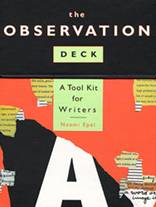 The Observation Deck: A Tool Kit for Writers The Observation Deck: A Tool Kit for Writers
By Naomi Epel
 "An I Ching for writers," says Jane Steinberg, of Amazon.com "An I Ching for writers," says Jane Steinberg, of Amazon.com
 This book and set of flash cards was inspired by the wisdom and needs of various novelists, journalists, self-help gurus, and children's book authors. This book and set of flash cards was inspired by the wisdom and needs of various novelists, journalists, self-help gurus, and children's book authors.
 Naomi Epel worked as a literary escort for nine years. If you don't know what a "literary escort" is, it's someone who drives touring authors to their interviews, book-signings, and makes sure that they're well-fed and on-time. Naomi Epel worked as a literary escort for nine years. If you don't know what a "literary escort" is, it's someone who drives touring authors to their interviews, book-signings, and makes sure that they're well-fed and on-time.
 While driving through the windy streets of San Francisco, Naomi had the rare opportunity to talk with best-selling authors about their methods of self-discipline, inspiration, and the techniques they use to hone their craft. From her experience and keen observation, she came up with The Observation Deck : a set of three-by-five cards meant to jump-start the creative process. While driving through the windy streets of San Francisco, Naomi had the rare opportunity to talk with best-selling authors about their methods of self-discipline, inspiration, and the techniques they use to hone their craft. From her experience and keen observation, she came up with The Observation Deck : a set of three-by-five cards meant to jump-start the creative process.
 I'll show you how this works. Let's say you're writing a story and you come to a crossroads where you aren't sure where you should go, or what you should write about. Shuffle the cards and allow chance to determine your next move! As I did this, I pulled out a card that said in bold letters, "ZOOM," and in small letters, "in and out." I'll show you how this works. Let's say you're writing a story and you come to a crossroads where you aren't sure where you should go, or what you should write about. Shuffle the cards and allow chance to determine your next move! As I did this, I pulled out a card that said in bold letters, "ZOOM," and in small letters, "in and out."
 That already sounds interesting, doesn't it? I picture my story taking on multiple angles, focusing on something that I may have never found significant before. That's enough to jump-start you right there, but there's more! That already sounds interesting, doesn't it? I picture my story taking on multiple angles, focusing on something that I may have never found significant before. That's enough to jump-start you right there, but there's more!
 After you've picked a card, you can open the book and look up the word, "ZOOM," and find an example of what this means to another author. In this case, the first paragraph says, "For novelist Amy Tan, the process of writing often begins with a single image-like a pair of chopsticks joined by a silver chain. Using her mind as a camera, Tan pulls back from the chopsticks to take in the larger picture-she sees the table on which the chopsticks lie, the dimly lit room in which the table sits, the different people moving around in the room. 'I focus on a specific image and that image takes me into a scene. Then I begin to see the scene and I ask myself, what's to your right? What's to your left? And I open up into this fictional world.'" - Amy Tan After you've picked a card, you can open the book and look up the word, "ZOOM," and find an example of what this means to another author. In this case, the first paragraph says, "For novelist Amy Tan, the process of writing often begins with a single image-like a pair of chopsticks joined by a silver chain. Using her mind as a camera, Tan pulls back from the chopsticks to take in the larger picture-she sees the table on which the chopsticks lie, the dimly lit room in which the table sits, the different people moving around in the room. 'I focus on a specific image and that image takes me into a scene. Then I begin to see the scene and I ask myself, what's to your right? What's to your left? And I open up into this fictional world.'" - Amy Tan
 This book and card set is packed with wonderful ideas for writers and offers creative advice from the pros. Naomi says, "It's not just a tool for writing; it is also a guide for living creatively. Not only will it help you finish the piece you've been meaning to write, it will give your thoughts a means of powerful expression and will allow you to experience the world in greater depth." And I believe she is right. It's a great source of inspiration, creativity, and you can't beat the price! This book and card set is packed with wonderful ideas for writers and offers creative advice from the pros. Naomi says, "It's not just a tool for writing; it is also a guide for living creatively. Not only will it help you finish the piece you've been meaning to write, it will give your thoughts a means of powerful expression and will allow you to experience the world in greater depth." And I believe she is right. It's a great source of inspiration, creativity, and you can't beat the price!
|
 |
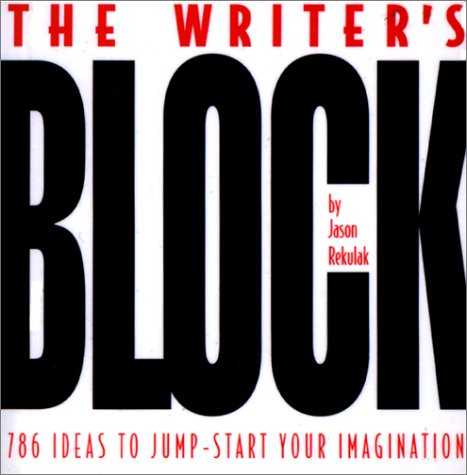 The Writer's Block: 786 Ideas To Jump-Start Your Imagination The Writer's Block: 786 Ideas To Jump-Start Your Imagination
By Jason Rekulak
 I wish I had a better picture of this, because this thing is an actual block. It's thick, square, and 3.1 x 3.2 x 2.9 inches. It looks like a hefty building block, a base that all your other columns, rectangles, and ABC blocks would be built upon, creating this magnificent fortress. Hey, it's a national bestseller and a great marketing gimmick! But for myself, as a writer, it gets kind-of annoying. I wish I had a better picture of this, because this thing is an actual block. It's thick, square, and 3.1 x 3.2 x 2.9 inches. It looks like a hefty building block, a base that all your other columns, rectangles, and ABC blocks would be built upon, creating this magnificent fortress. Hey, it's a national bestseller and a great marketing gimmick! But for myself, as a writer, it gets kind-of annoying.
 I admit, it's jam-packed full of wonderful prompts, pictures, spark words, and wisdom from famous authors. Yet, there's no table of contents, and if you're supposed to flip to a random page, you somehow keep flipping to some of the pages that you've already been to, due to it's odd size and the creases in the spine. I admit, it's jam-packed full of wonderful prompts, pictures, spark words, and wisdom from famous authors. Yet, there's no table of contents, and if you're supposed to flip to a random page, you somehow keep flipping to some of the pages that you've already been to, due to it's odd size and the creases in the spine.
 However, it's a bestseller for a reason, because it contains some of the best prompts and ideas out there! You just have to be ready to deal with the format, otherwise, you'll never get anything out of it. However, it's a bestseller for a reason, because it contains some of the best prompts and ideas out there! You just have to be ready to deal with the format, otherwise, you'll never get anything out of it.
 I'd like to sit down one day and read it from cover to cover, making note of the good articles from authors, but in its present format, it's too difficult to read. I'd like to sit down one day and read it from cover to cover, making note of the good articles from authors, but in its present format, it's too difficult to read. |
 |
| Style and Mechanics: |
 |
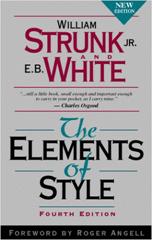 The Elements of Style: Fourth Edition The Elements of Style: Fourth Edition
By William Strunk jr. and E.B. White
 This is the standard, end-all reference on style and mechanics, isn't it? If you've been writing for one second, everyone recommends this book as a reference to this thing called, "style," from authors to teachers, to writing companions and critique groups across the nation. You all know it, have it, have heard of it, and have read it, at some point or another. Yet, how many of you actually understand it? This is the standard, end-all reference on style and mechanics, isn't it? If you've been writing for one second, everyone recommends this book as a reference to this thing called, "style," from authors to teachers, to writing companions and critique groups across the nation. You all know it, have it, have heard of it, and have read it, at some point or another. Yet, how many of you actually understand it?
 Behind the confines of a selective writing circle, you may find that this book, touted as the "writer's bible of style," is not as comprehensive as it's cracked-up to be. In an honest conversation with a fellow writer, I'd said, "Sometimes the wording is archaic and the explanations are downright confusing." Then she replied, "Thank you!" Behind the confines of a selective writing circle, you may find that this book, touted as the "writer's bible of style," is not as comprehensive as it's cracked-up to be. In an honest conversation with a fellow writer, I'd said, "Sometimes the wording is archaic and the explanations are downright confusing." Then she replied, "Thank you!"
 It's hard to say this about a book that has such a great reputation. Perhaps my snuggly cat has got the best of me, or I suffer from A.D.D. because of watching too many cartoons. It's hard to say this about a book that has such a great reputation. Perhaps my snuggly cat has got the best of me, or I suffer from A.D.D. because of watching too many cartoons.
 Don't get me wrong, it's a great book to have on your shelf, there's no disputing that fact. But for an easy way out, I say stick to ms word and you'll find out if your sentences are passive or fragmented, and what your Flesch-Kincaid reading level is. (i.e. If you copy this article into ms word, the passive sentence rate is 0%.) Don't get me wrong, it's a great book to have on your shelf, there's no disputing that fact. But for an easy way out, I say stick to ms word and you'll find out if your sentences are passive or fragmented, and what your Flesch-Kincaid reading level is. (i.e. If you copy this article into ms word, the passive sentence rate is 0%.)
|
 |
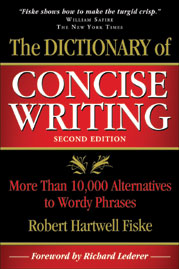
The Dictionary of Concise Writing: 10,000 Alternatives to Wordy Phrases
By Robert Hartwell Fiske
 This is a useful resource if you're editing your writing and want to cut words to be precise. I often forget to consult this, but it can be very handy if there's a specific word count. For instance, let's say you are editing your work and you have a phrase such as, "in no time at all." You can look up that phrase and it'll give you the alternatives: "promptly; quickly; rapidly; right away; shortly; soon; speedily; swiftly." You just have to remember that it's in your library! This is a useful resource if you're editing your writing and want to cut words to be precise. I often forget to consult this, but it can be very handy if there's a specific word count. For instance, let's say you are editing your work and you have a phrase such as, "in no time at all." You can look up that phrase and it'll give you the alternatives: "promptly; quickly; rapidly; right away; shortly; soon; speedily; swiftly." You just have to remember that it's in your library!
|
 |
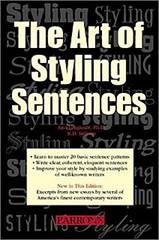 The Art of Styling Sentences: Fourth Edition The Art of Styling Sentences: Fourth Edition
By Ann Longknife, Ph.D., and K.D. Sullivan
 The authors compiled this book to help their students improve their writing style. That's why it reads like a classroom book, although not quite as hefty. In fact, it's a slim book that you can get through in a day, if you feel the need for a cram-session. The authors compiled this book to help their students improve their writing style. That's why it reads like a classroom book, although not quite as hefty. In fact, it's a slim book that you can get through in a day, if you feel the need for a cram-session.
 Every chapter has exercises that involve a "fill-in-the-blanks" type workshop, along with author examples, pattern, explanation, and a "when to use this pattern" guide. It takes some effort on your part, but that's what makes it comprehensive. Every chapter has exercises that involve a "fill-in-the-blanks" type workshop, along with author examples, pattern, explanation, and a "when to use this pattern" guide. It takes some effort on your part, but that's what makes it comprehensive.
 I read through the entire book in one night, grabbed a blank composition book for my exercises, completed a few chapters, but never finished it all. It serves as a good refresher course. I read through the entire book in one night, grabbed a blank composition book for my exercises, completed a few chapters, but never finished it all. It serves as a good refresher course.
|
 |
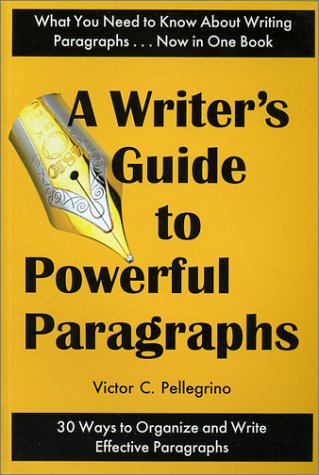 A Writer's Guide to Powerful Paragraphs: 30 Ways to Organize and Write Effective Paragraphs A Writer's Guide to Powerful Paragraphs: 30 Ways to Organize and Write Effective Paragraphs
By Victor C. Pellegrino
 This book is a great guide for non-fiction writers and students writing essays. I wouldn't exactly recommend it for fiction writers, although they can probably use some of the tips within. This is a guide for organizing your thoughts. It includes thirty ways to write paragraphs, from chronological to climactic. Every page is glossy and the fonts are large. It contains examples, analysis, and practical suggestions. Thinking about this now, I may want to revisit this book for my non-fiction writing. At the time I was reading this book, I was working on a novel, and it didn't hold much interest for me. When reviewing it now, almost a year later, I find it quite fascinating and a necessary tool for learning the skills of school essays and on-the-job writing. This book is a great guide for non-fiction writers and students writing essays. I wouldn't exactly recommend it for fiction writers, although they can probably use some of the tips within. This is a guide for organizing your thoughts. It includes thirty ways to write paragraphs, from chronological to climactic. Every page is glossy and the fonts are large. It contains examples, analysis, and practical suggestions. Thinking about this now, I may want to revisit this book for my non-fiction writing. At the time I was reading this book, I was working on a novel, and it didn't hold much interest for me. When reviewing it now, almost a year later, I find it quite fascinating and a necessary tool for learning the skills of school essays and on-the-job writing.
|
 |
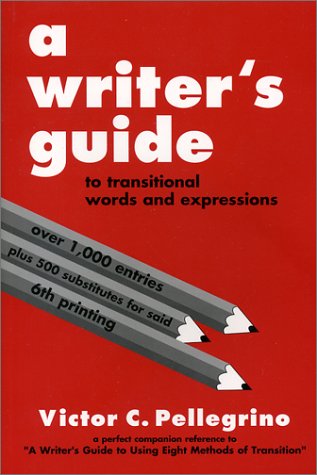 A Writer's Guide to Transitional Words and Expressions A Writer's Guide to Transitional Words and Expressions
By Victor C. Pellegrino
 Conveniently divided into tabs, and thumb indexed into fifteen categories, this lightweight book is easy to use. Conveniently divided into tabs, and thumb indexed into fifteen categories, this lightweight book is easy to use.
 The categories include alternative ways to: The categories include alternative ways to:
• Indicate time order
• Indicate how or when something occurs in time
• Indicate Sequence
• Provide an example
• Concede
• Conclude or summarize
• Add a point
• Compare
• Contrast
• Indicate cause and effect
• Divide or classify
• Indicate spatial arrangement
• Emphasize or intensify
• Connect clauses
• Substitutes for said |
 |
| Voice and Description: |
 |
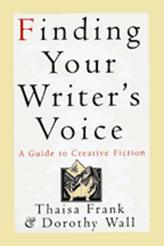 Finding Your Writer's Voice: A Guide to Creative Fiction Finding Your Writer's Voice: A Guide to Creative Fiction
By Thaisa Frank & Dorothy Wall
 No wonder this book was chosen by Writer's Digest as "one of the best books of the year." It's an amazing book written by two highly creative women. This book delves into this mysterious thing called, "voice," dissects it and breaks it down into a musical structure. No wonder this book was chosen by Writer's Digest as "one of the best books of the year." It's an amazing book written by two highly creative women. This book delves into this mysterious thing called, "voice," dissects it and breaks it down into a musical structure.
 This book made me fall in love with the art of writing again, and the immense love I have for description. It's the meat of the written word, what literary fiction writers strive for, that exclusive vocabulary that can only come from you-your unique voice. This book made me fall in love with the art of writing again, and the immense love I have for description. It's the meat of the written word, what literary fiction writers strive for, that exclusive vocabulary that can only come from you-your unique voice.
 The excerpts shared in this book are poignant and their techniques revolutionary. The exercises may be a little "out there" for some, which include dressing in drag and locking yourself in a dark closet to eat ice cream, but for the most part, the text is something that you can definitely benefit and grow from. The excerpts shared in this book are poignant and their techniques revolutionary. The exercises may be a little "out there" for some, which include dressing in drag and locking yourself in a dark closet to eat ice cream, but for the most part, the text is something that you can definitely benefit and grow from.
|
 |
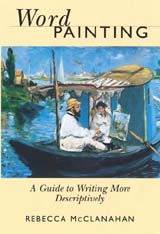 Word Painting: A guide to Writing More Descriptively Word Painting: A guide to Writing More Descriptively
By Rebecca McClanahan
 For many writers, description is merely a background or an ornament to their stories. In this book, Rebecca demonstrates how description can be used as a vital tool, a concise tool, and a means to awaken stagnant sentences from their slumber to an exciting illustration, simply from a choice of the right words. Her book gives you the inspiration and means necessary to turn flat unimaginative-writing into poetry and prose. For many writers, description is merely a background or an ornament to their stories. In this book, Rebecca demonstrates how description can be used as a vital tool, a concise tool, and a means to awaken stagnant sentences from their slumber to an exciting illustration, simply from a choice of the right words. Her book gives you the inspiration and means necessary to turn flat unimaginative-writing into poetry and prose.
 I haven't yet conquered this book in full, but have read a few chapters and found it utterly fascinating. This book is on my to-do list and part of my weekly goal! I haven't yet conquered this book in full, but have read a few chapters and found it utterly fascinating. This book is on my to-do list and part of my weekly goal!
|
 |
| Novel Writing: |
 |
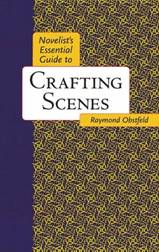 Novelist's Essential Guide to Crafting Scenes Novelist's Essential Guide to Crafting Scenes
By Raymond Obstfeld
 This is one of the first books I bought after my mad stint of blind-fervor novel writing. I can't remember why I chose this book, but I'm glad that I did. This is one of the first books I bought after my mad stint of blind-fervor novel writing. I can't remember why I chose this book, but I'm glad that I did.
 Obstfeld does something that I've never seen done before. He takes a scene and shows you how to tailor it, whether it's through character, plot or theme. He has the ability to tweak a scene, using the same words, and produce a completely different outcome, simply by adding gestures and/or description. It's amazing. Same dialogue, totally different story. You have to read it to believe it. He's a literary magician! Obstfeld does something that I've never seen done before. He takes a scene and shows you how to tailor it, whether it's through character, plot or theme. He has the ability to tweak a scene, using the same words, and produce a completely different outcome, simply by adding gestures and/or description. It's amazing. Same dialogue, totally different story. You have to read it to believe it. He's a literary magician!
 Raymond Obstfeld has written over twenty-seven novels in a variety of genres. He teaches at Orange Coast College in Costa Mesa, California, and his teaching techniques are rather unconventional. This book is a little older, but it's solid throughout, and still one of my favorites. Almost every time I read this, I learn something new. Raymond Obstfeld has written over twenty-seven novels in a variety of genres. He teaches at Orange Coast College in Costa Mesa, California, and his teaching techniques are rather unconventional. This book is a little older, but it's solid throughout, and still one of my favorites. Almost every time I read this, I learn something new.
|
 |
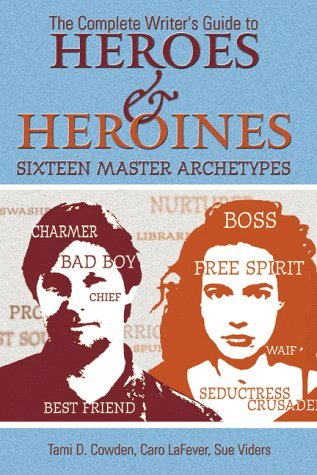 The Complete Writer's Guide to Heroes & Heroines: Sixteen Master Archetypes The Complete Writer's Guide to Heroes & Heroines: Sixteen Master Archetypes
By Tami D. Cowden, Caro LaFever, Sue Viders
 If you're looking for characters to leap off the page in your commercial fiction, then this is your reference book. These ladies have come up with an easy-to-use system, based upon the eight major classical archetypes. If you're looking for characters to leap off the page in your commercial fiction, then this is your reference book. These ladies have come up with an easy-to-use system, based upon the eight major classical archetypes.
 They break it down, covering personality traits, what an archetype is likely or unlikely to do, who their compatible archetype is, who their nemesis is, and offer variations of each. This is a great book for screenwriters and fiction writers. I may have to consult this once again to find out which archetypes my characters fall into for my fiction writing, and which ones my real-life friends fall into as well. Either way, it's an interesting and useful resource. They break it down, covering personality traits, what an archetype is likely or unlikely to do, who their compatible archetype is, who their nemesis is, and offer variations of each. This is a great book for screenwriters and fiction writers. I may have to consult this once again to find out which archetypes my characters fall into for my fiction writing, and which ones my real-life friends fall into as well. Either way, it's an interesting and useful resource.
|
 |
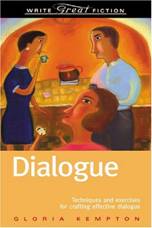 Dialogue: Techniques and exercises for crafting effective dialogue Dialogue: Techniques and exercises for crafting effective dialogue
By Gloria Kempton
 The dialogue that Gloria chooses to exemplify in her book is excellent. She's a great writer, which makes the book an easy read. I haven't fully delved into this book, but have often used it as reference when I have an issue with my writing, say, intensifying the conflict through dialogue. I'll look up that subject, read a little, and immediately get inspired to write something. Sorry Gloria, but that's what your book does to me-and that's a good thing! The dialogue that Gloria chooses to exemplify in her book is excellent. She's a great writer, which makes the book an easy read. I haven't fully delved into this book, but have often used it as reference when I have an issue with my writing, say, intensifying the conflict through dialogue. I'll look up that subject, read a little, and immediately get inspired to write something. Sorry Gloria, but that's what your book does to me-and that's a good thing!
|
 |
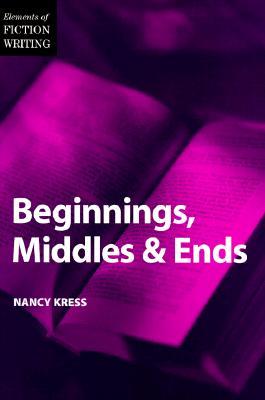 Beginnings, Middles & Ends Beginnings, Middles & Ends
By Nancy Kress
 This is a rare opportunity to gain wisdom from a great author and Hugo award winner. Many reviewers have called this book the best in the series, and I can see why. It's a pleasure to read, and extremely helpful. Kress shows you how to translate a flash of inspiration into a compelling story, and she makes it sound so easy! This is a rare opportunity to gain wisdom from a great author and Hugo award winner. Many reviewers have called this book the best in the series, and I can see why. It's a pleasure to read, and extremely helpful. Kress shows you how to translate a flash of inspiration into a compelling story, and she makes it sound so easy!
 Nancy includes some sound advice, such as, the price a writer pays for flashbacks, six ways characters should "reveal" themselves, techniques on rewriting, and how to hook an editor in the first three paragraphs. This is a great book to have in your library and one that you'll often revisit. Nancy includes some sound advice, such as, the price a writer pays for flashbacks, six ways characters should "reveal" themselves, techniques on rewriting, and how to hook an editor in the first three paragraphs. This is a great book to have in your library and one that you'll often revisit.
|
 |
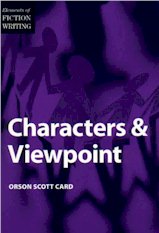 Characters & Viewpoint Characters & Viewpoint
By Orson Scott Card
 If you want to know what viewpoint is all about, this book is a good reference. Card goes into nearly all aspects of creating a character and tells you how to keep that character interesting. The major downfall of this book, in my opinion, is that it tries to convince you to write in third person. For Card, it seems, there is no other viewpoint. If you want to know what viewpoint is all about, this book is a good reference. Card goes into nearly all aspects of creating a character and tells you how to keep that character interesting. The major downfall of this book, in my opinion, is that it tries to convince you to write in third person. For Card, it seems, there is no other viewpoint.
 Although, I do like to write in third person when it comes to fiction writing, but that doesn't mean that it's right for everyone. Card is adamant about first time authors writing in third person. He feels that it's more immediate than first person, and that editors won't want to read anything else from a first time novelist. I say, cruise the bestseller aisle at your local bookstore and you'll find the majority written in first person. Although, I do like to write in third person when it comes to fiction writing, but that doesn't mean that it's right for everyone. Card is adamant about first time authors writing in third person. He feels that it's more immediate than first person, and that editors won't want to read anything else from a first time novelist. I say, cruise the bestseller aisle at your local bookstore and you'll find the majority written in first person.
|
 |
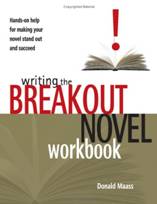 Writing the Breakout Novel Workbook: Hand-On Help for Making Your Novel Stand Out and Succeed Writing the Breakout Novel Workbook: Hand-On Help for Making Your Novel Stand Out and Succeed
By Donald Maass
 Want to flesh out your novel, create compelling characters, and build plot layers for your blockbuster novel? Then this book will help you get there. It's like taking a class without leaving your home. I haven't actually used this book, but I plan to some day! It's a great book for commercial fiction writers and a solid guide for new authors. If you don't know what steps to take on structuring your novel, then this will help a great deal. Want to flesh out your novel, create compelling characters, and build plot layers for your blockbuster novel? Then this book will help you get there. It's like taking a class without leaving your home. I haven't actually used this book, but I plan to some day! It's a great book for commercial fiction writers and a solid guide for new authors. If you don't know what steps to take on structuring your novel, then this will help a great deal.
|
 |
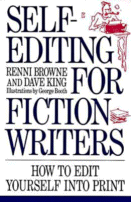 Self-Editing For Fiction Writers: How to Edit Yourself into Print Self-Editing For Fiction Writers: How to Edit Yourself into Print
By Renni Browne and David King
 As far as I know, this is the only book of its kind. And it's a good one. Both Renni Browne and Dave King worked as senior editors and teachers. This book goes into topics such as, show and tell, characterization and exposition, point of view, dialogue mechanics, interior monologue and much more. It's complete with classroom exercises and answers to those exercises at the back of the book, so you can actually test yourself and find out if you're on track. As far as I know, this is the only book of its kind. And it's a good one. Both Renni Browne and Dave King worked as senior editors and teachers. This book goes into topics such as, show and tell, characterization and exposition, point of view, dialogue mechanics, interior monologue and much more. It's complete with classroom exercises and answers to those exercises at the back of the book, so you can actually test yourself and find out if you're on track.
 Learning how to edit your own writing, is one of the hardest struggles we writers face. It's difficult to be objective when it comes to your own work, isn't it? That's why this book is necessary to any fiction writer looking to create a polished manuscript that's ready for submission. And if you can learn how to do it yourself, then you won't have to shell out a bunch of money for a book doctor. Learning how to edit your own writing, is one of the hardest struggles we writers face. It's difficult to be objective when it comes to your own work, isn't it? That's why this book is necessary to any fiction writer looking to create a polished manuscript that's ready for submission. And if you can learn how to do it yourself, then you won't have to shell out a bunch of money for a book doctor.
|
 |
| Books on Writing: |
 |
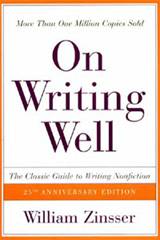 On Writing Well: The Classic Guide to Writing Nonfiction On Writing Well: The Classic Guide to Writing Nonfiction
By William Zinsser
 Whether you want to write about people, places, science, business, sports, or memoirs, this book has the fundamental principles to get you there. Whether you want to write about people, places, science, business, sports, or memoirs, this book has the fundamental principles to get you there.
 Zinsser teaches you how to write with clarity and gives you the tools for your magazine, article and nonfiction writing. No wonder this book is considered a classic guide, up there with The Elements of Style . It's a good one to have by your side. Zinsser teaches you how to write with clarity and gives you the tools for your magazine, article and nonfiction writing. No wonder this book is considered a classic guide, up there with The Elements of Style . It's a good one to have by your side.
|
 |
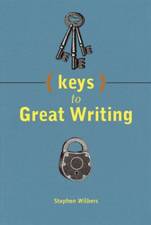 Keys to Great Writing Keys to Great Writing
By Stephen Wilbers
 "Keys to Great Writing presents five elements of style (economy, precision, action, music, and personality), five elements of composition (purpose, point of view, organization, support, and coherence), an approach to drafting and revising, a brief glossary of grammatical terms, a checklist for writing with style, a checklist for proofreading, and a list of writing resources." "Keys to Great Writing presents five elements of style (economy, precision, action, music, and personality), five elements of composition (purpose, point of view, organization, support, and coherence), an approach to drafting and revising, a brief glossary of grammatical terms, a checklist for writing with style, a checklist for proofreading, and a list of writing resources."
 I grazed through this book and it looks very comprehensive, although I haven't actually made the commitment to read through this as of yet. I plan to, but I know it'll take some work and strong coffee from my perspective. The book is straight forward, non-conversational, and divided into clear sections. I tend to lean towards books that share stories and examples, so this will be one that takes deep concentration. I do believe it's worth it though. I'll let you know. I grazed through this book and it looks very comprehensive, although I haven't actually made the commitment to read through this as of yet. I plan to, but I know it'll take some work and strong coffee from my perspective. The book is straight forward, non-conversational, and divided into clear sections. I tend to lean towards books that share stories and examples, so this will be one that takes deep concentration. I do believe it's worth it though. I'll let you know.
|
 |
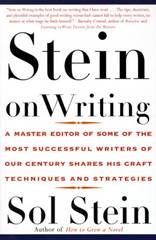 Stein On Writing: A Master Editor of some of the most successful writers of our century shares his craft techniques and strategies Stein On Writing: A Master Editor of some of the most successful writers of our century shares his craft techniques and strategies
By Sol Stein
 "The best reading experiences," says Sol Stein, "defy interruption." "The best reading experiences," says Sol Stein, "defy interruption."
 Stein is a renowned editor, author and instructor, who has edited many bestselling novels. It's always great to get advice from a real pro! This book offers detailed sections on characterization, dialogue, pacing, flashbacks, liposuctioning flab, the "triage" method of revision, and many more wonderful techniques to enhance your fiction and nonfiction writing. This book is a great add for your writing collection. Stein is a renowned editor, author and instructor, who has edited many bestselling novels. It's always great to get advice from a real pro! This book offers detailed sections on characterization, dialogue, pacing, flashbacks, liposuctioning flab, the "triage" method of revision, and many more wonderful techniques to enhance your fiction and nonfiction writing. This book is a great add for your writing collection.
|
 |
            |
 |
 Phew! That was a workout. I knew I had an enthusiastic eye and a desire to learn the craft of writing, but I didn't know how extensive my library had actually become! I suppose pretty soon I could start my own lending program and make library cards. I wonder how typical this is for new writers? Phew! That was a workout. I knew I had an enthusiastic eye and a desire to learn the craft of writing, but I didn't know how extensive my library had actually become! I suppose pretty soon I could start my own lending program and make library cards. I wonder how typical this is for new writers?
 There are a few books I didn't include because either they were out-of-print or I was too ladylike to include them. There are a few books I didn't include because either they were out-of-print or I was too ladylike to include them.
 One of the ones I wanted to include was Mr. Lukeman's, "The First Five Pages," but since Beryl did such a lovely review on that one last time, I'll let you check out hers. You won't want to miss it! But in case you did, you can see it here: The First Five Pages . helps to level the playing field One of the ones I wanted to include was Mr. Lukeman's, "The First Five Pages," but since Beryl did such a lovely review on that one last time, I'll let you check out hers. You won't want to miss it! But in case you did, you can see it here: The First Five Pages . helps to level the playing field
 Now I want to know. what's on your shelf? Now I want to know. what's on your shelf?
|